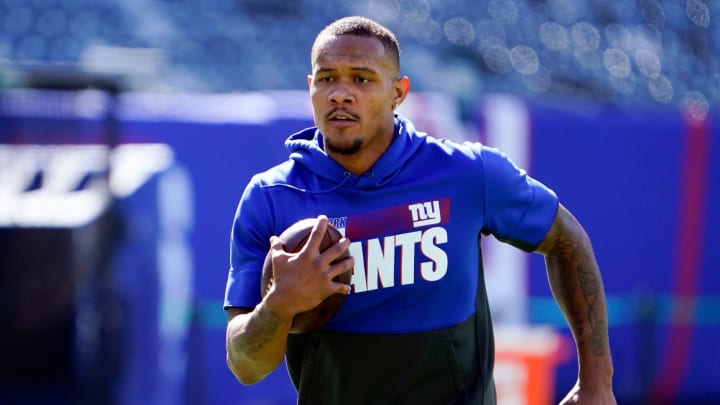The New York Giants' $72 Million Dilemma

In this story:
When the New York Giants signed receiver Kenny Golladay two off-seasons ago, they were hoping for the second coming of Plaxico Burress.
Instead, what they've gotten thus far for the four-year, $72 million investment made in the 6-foot-4, 214-pound Golladay is a lot of disappointment highlighted by games missed due to injury, an inability to separate or consistently win jump balls, and no touchdowns contributed in 75 regular-season pass targets last season.
"I think he’s acclimated himself well in terms of what we’re doing," said head coach Brian Daboll. "All receivers--they’re different. Some are shifty and quick. Some are big and physical. It’s just a matter of when you have an opportunity to go out there and make plays, which he’s made some of them, that you go ahead and make them."
Whatever plays Golladay has made in the preseason, it's probably fair to say there haven't been enough to keep the team from stifling a growing sense of buyer's remorse. During Sunday's practice, Golladay could not come up with any receptions despite having two balls thrown his way in team drills.
And in the preseason opener last week against the Patriots, he caught one of three pass targets for six yards, with one dropped ball inside the red zone that, if he had caught, would have given the giants six instead of three.
Golladay's struggles with separating are nothing new. According to NFL NextGen Stats, Golladay tied for last with Miami's Devante Parker for the lowest average separation yards (1.7) based on a minimum of 45 pass targets.
But that wouldn't be so bad if Golladay, who in 2021 posted a 48.4 percent contested catch rate, the second lowest rate of his career, was coming up with some of the jump balls his size suggests he should be winning more of with ease.
Daboll said no specific magic number serves as a benchmark to tell when receivers are successful at separating.
"Let’s just say in our league, it’s hard to create. When it’s man-to-man coverage, it’s press, man-to-man coverage, it’s a little bit different in college where that goes into a whole other conversation of evaluating quarterbacks, receivers and trying to take off every man-to-man clip that’s press relative to some of the softer zone or maybe there’s just better players. Here, it’s pretty tight usually," he said.
The head coach was also asked if a receiver's struggles to separate has anything to do with the timing of when the ball is thrown, an answer.
"There are some elite route runners that have great quickness, ability to get in and out of breaks. And even those, it’s not like they’re open by a ton," he said.
"Again, different players get open different. I had a tight end that was a pretty good tight end – a big body guy that you just throw it up to him, and he makes plays when they’re right next to him. And those guys are good to have.
"Every skill guy’s different, whether it’s a back, a tight end. And you have to try to figure out, as a coaching staff, what their strengths are and let them try to go ahead and do it."
Although Golladay missed the spring while recovering from an undisclosed medical issue, one might have thought that by now, the coaching staff would know what Golladay's strengths are.
That either isn't the case, or maybe there was just too much expected of the former Detroit Lion receiver.
Whatever the reason behind Golladay's struggles, Daboll doesn't believe it's due to effort or lack thereof.
"I’ve been pleased with how he’s handled himself," Daboll said of Golladay. "He’s been a pro, and he’s competing every day with those guys."
Join the Giants Country Community
- Sign up for our FREE digest newsletter
- Follow and like us on Facebook
- Submit your questions for our mailbag
- Check out the new Giants Country YouTube Channel.
- Listen and subscribe to the daily LockedOn Giants podcast.
- Subscribe and like the LockedOn Giants YouTube Channel
- Sign up for our FREE message board forums

Patricia Traina has covered the New York Giants for 30+ seasons, and her work has appeared in multiple media outlets, including The Athletic, Forbes, Bleacher Report, and the Sports Illustrated media group. As a credentialed New York Giants press corps member, Patricia has also covered five Super Bowls (three featuring the Giants), the annual NFL draft, and the NFL Scouting Combine. She is the author of The Big 50: The Men and Moments that Made the New York Giants. In addition to her work with New York Giants On SI, Patricia hosts the Locked On Giants podcast. Patricia is also a member of the Pro Football Writers of America and the Football Writers Association of America.
Follow Patricia_Traina